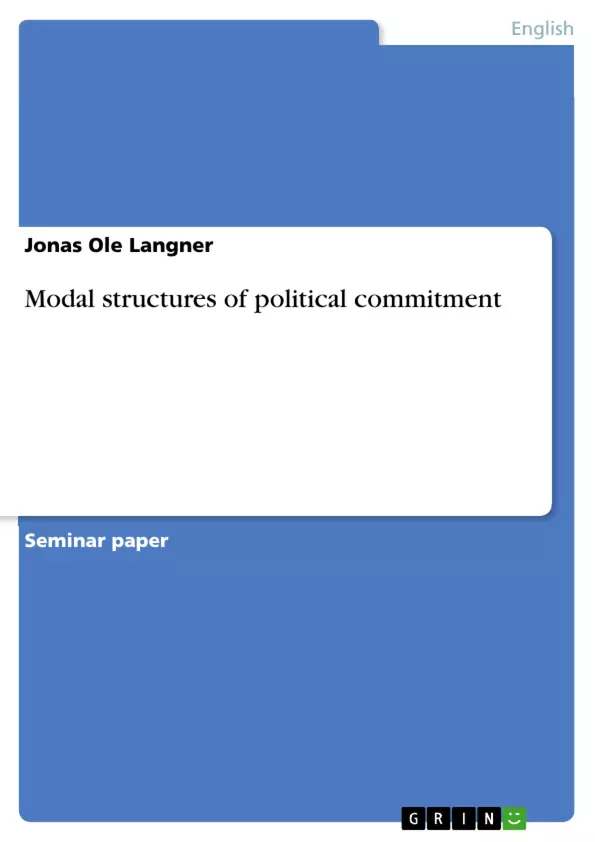According to Downing and Locke “[m]odality is the category by which speakers express attitudes towards the event contained in the proposition” (Downing: 1992, 381). So when it comes to analysing political commitments concerning their modal structures, this will be a question of how far the speaker commits himself to the content of his speech. “[M]odality is [also] said to express arelationto reality, whereas an unmodalised declarative treats the processasreality” (Downing: 1992, 382). Especially in the field of politics, that is often regarded as a ‘game of lies and intrigues’. It is interesting to find out whether a politician really believes what he says or how he hides his real opinion behind the tools modality gives him. Modality gives us the opportunity to make an utterance sound clear and certain at first glance and it is only revealed at a closer look that the speaker is not as convinced as it seems to be. This term paper can be divided into two parts. The first part of it will be concerned with the theory of modality. As mood is closely linked to modality, it will start with giving a short introduction to this topic. This will also be helpful for the analysis at the end of this paper. Additionally, the topic of this paper is classified to the level of interpersonal meaning, which “[…] is expressed by choices from several different areas of the language which include modality, intonation and […] ‘moods’” (Downing: 1992, 164). This emphasizes the importance of dealing with mood in this paper. For obvious reasons it will not be possible though to analyse the text in the end concerning the speaker’s intonation. This chapter will be followed by explaining what modality is all about. The author of this term paper decided to orientate himself according to the division made by Downing and Locke, namely that of extrinsic modality on the one hand and that of instrinsic modality on the other (cf. Downing: 1992, 381-402). Most other concepts of modality by Lock, Quirk, Yule, and others can be adapted to this one, although some of them differ in their terms. [...]
Inhaltsverzeichnis (Table of Contents)
- I. Introduction
- II. Mood
- III. Modality
- III.1 Extrinsic modality
- III.1.1 Certainty
- III.1.2 Probability
- III.1.3 Possibility
- III.2 Intrinsic modality
- III.2.1 Volition
- III.2.2 Obligation and necessity
- III.2.3 Intrinsic possibility, ability, permission
- III.1 Extrinsic modality
- IV. Realisation of modal meanings
- V. Text Study
- VI. Results
- VII. References
Zielsetzung und Themenschwerpunkte (Objectives and Key Themes)
This paper examines the modal structures of political commitment in a speech by Tony Blair, focusing on how far the speaker commits himself to the content of his speech. The analysis investigates the relationship between modality and reality, exploring how politicians use linguistic tools to convey certainty or conceal their true opinions.
- Modality as an expression of speaker's attitude towards the proposition.
- The relationship between modality and reality in political discourse.
- The use of modal verbs and structures to convey certainty, probability, and possibility.
- The analysis of a specific political speech to identify patterns of modal usage.
- The impact of modal structures on the interpretation of political statements.
Zusammenfassung der Kapitel (Chapter Summaries)
- I. Introduction: This chapter introduces the concept of modality and its significance in analyzing political commitments. It highlights the importance of understanding how speakers use modality to express their attitudes and convey different levels of certainty or commitment.
- II. Mood: This chapter provides an overview of different mood types in English grammar, including declarative, interrogative, imperative, and exclamative. It explains how these moods are realized syntactically and their relevance in analyzing the structure of political statements.
- III. Modality: This chapter delves into the concept of modality, exploring its different categories, including extrinsic modality (certainty, probability, possibility) and intrinsic modality (volition, obligation, necessity, possibility, ability, permission). It discusses how these categories are realized in language and their significance in interpreting political statements.
- IV. Realisation of modal meanings: This chapter examines the different ways in which modal meanings are realized in language, highlighting the various linguistic tools that speakers use to express modality. It provides insights into how these tools contribute to the overall meaning and interpretation of political statements.
- V. Text Study: This chapter focuses on the analysis of a speech by Tony Blair, exploring the modal structures used and their implications for understanding the speaker's commitment and the intended message. It examines how modality is employed to convey certainty, ambiguity, or a sense of caution.
Schlüsselwörter (Keywords)
This term paper examines the modal structures of political commitment, focusing on how speakers use language to express their attitudes and convey different levels of certainty or commitment. Key concepts include modality, mood, extrinsic modality, intrinsic modality, modal verbs, modal structures, political discourse, and speech analysis.
- Citar trabajo
- Jonas Ole Langner (Autor), 2005, Modal structures of political commitment, Múnich, GRIN Verlag, https://www.grin.com/document/59078



